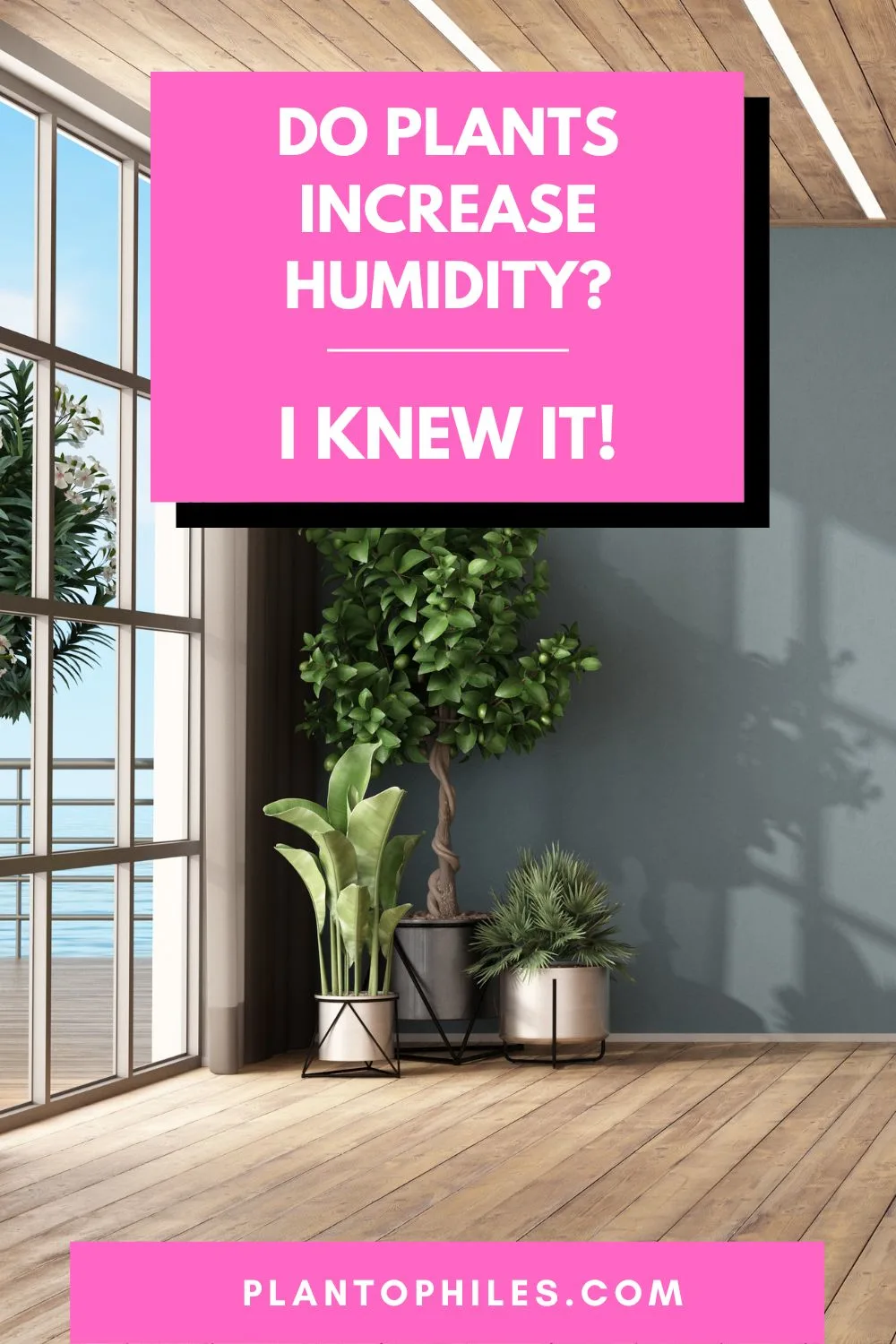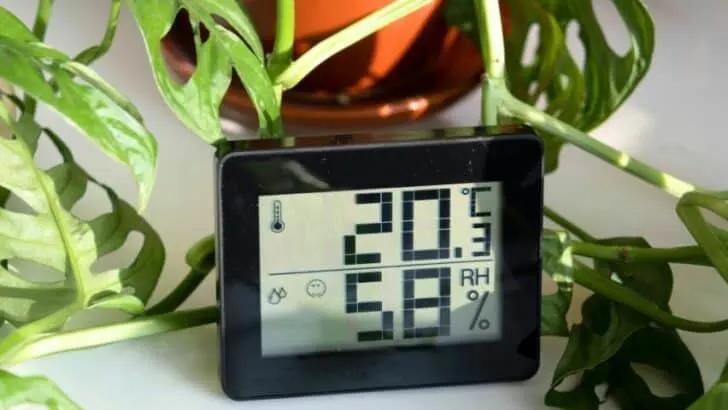Have you ever wondered if your beloved houseplants do more than just brighten up your living space?
Picture this: while they add a touch of nature indoors, could they also be subtly altering the very air you breathe?
Well, let’s find out!
Table of Contents
Do Houseplants Increase Humidity?
Most houseplants increase humidity because they undergo respiration and photosynthesis. They absorb water while making their food. Later, houseplants release about 97% of this moisture in the air through transpiration and evaporation. They also generate more water vapors.
What Does Humidity Really Mean?
If you search the internet for humidity levels for different locations, you will find that each answer has a percentage as its unit. Based on your location, it could be anywhere from 40% to 90%.
In simple words, the air has a specific capacity for holding water vapor. Suppose the air in a place comprises 70% of the total water vapor it could contain.
In that place, weathermen would report the humidity as 70%. So, houseplants increasing the humidity means raising the water vapor concentration in a room.
Which Houseplants Raise Moisture in the Room?
Most indoor plants increase humidity, but sometimes, the change is not noticeable.
This is because plants have different growing habits and patterns. Some transpire more water, others not as much.
You can recognize the ones that add more moisture by observing their leaves. Humidity-raising plants often have leaves with a large surface area.
They come from rainforests and tropical regions.
The most popular choices include Philodendron, Spider plants, and Jade plants.
Spider plants have wiry stems and shoots that grow in all directions.
They can also produce baby Spider plants that some people fondly call “pups.”
These plants are a pleasant sight.
Plant lovers also prize Jade plants.
These have small and succulent leaves.
Many believe that these symbolize good luck and wealth for their owners. Jade plants transpire in dark areas as they don’t need a lot of light.
So, getting Jade plants for cold months will help you keep the home humid.
Philodendron are probably the most popular houseplants out there.
Every plant enthusiast I know has some species of Philodendron in their house.
Besides adding beauty, they also contribute to humidity levels.
However, unlike Jade and Spider plants, Philodendrons like humid environments.
It means that you would have to provide them with moist air first before they can raise its level!
If you consider getting these houseplant species, you can read more about Philodendron Pastazanum and Philodendron Patriciae.
If you don’t live in a dry and arid place, you can look into low-humidity plants like cacti. They will gladly help you out by releasing moisture without asking for much in return.

How Do Houseplants Raise Humidity?
When summer temperatures get too hot, people sweat to release heat. Likewise, houseplants are also naturally inclined to sweat. They do this through a procedure called evapotranspiration.
Generally speaking, evapotranspiration begins when the roots of houseplants absorb water from the soil.
Houseplants have xylem vessels in their stems.
Once roots absorb water, these vessels exert pressure to pull the water upwards. You can compare this movement with what happens when you are drinking juice from a straw.
The excess water from vessels evaporates from the surface of the leaves. It is made possible by the minute openings in leaves. These are known as stomata.
They regulate gas and vapor exchange in houseplants.
Once the water accumulates on the surface, it can evaporate in the air. It happens because the surrounding air is less humid than the leaf surface.
For many plants, this rise in humidity is negligible.
But if you keep several pots in your home, they are more likely to raise the percentage of water vapor in the air.
Factors that Can Affect Evapotranspiration
You may notice that your houseplants are not affecting the humidity level as expected. It is possible due to several reasons. Learning these will help you boost evapotranspiration in your plants.
Temperature
Like humans, plants also eliminate more water from their bodies if the external temperature is high.
When summer approaches, the stomata in your houseplants will open more than usual. It will speed up the evaporation and transpiration.
Alternatively, if your houseplants are not generating moisture, they might be cold. Placing them outdoors in the afternoon can solve this issue if they can tolerate direct sun.
Availability of Water in the Soil
The water that evaporates from plants comes from their roots originally.
So, if your houseplant is dehydrated, it is unlikely to humidify the air.
The water pressure in stomata cells is not enough to push them open. So, vapors do not escape, and the surrounding air stays the same.
Light
Humidity is connected to stomata, which are linked to light. As part of their natural cycle, the stomata of most houseplants open when they receive sunlight. If your houseplant consistently stays in the dark, it will not likely humidify your air.
However, this rule has some exceptions. Some houseplants, like Jade plants, also actively transpire at night. If you don’t have a very sunny or well-lit home, you should consider getting such plants instead.
Humidity
Interestingly, the existing humidity levels at your home also affect evapotranspiration in plants. The current level is also known as “relative humidity.”
Transpiration and evaporation occur when the relative humidity is lower than the moisture present in plant leaves. So, when the humidity level is high, it can discourage your plants from transpiring.
Fortunately, you can manually adjust the humidity levels.
When my plants seem too humid, I space them out. If you have several pots placed together, creating spaces will allow the air to pass. Warming up the floor also helps.
In some cases, houseplants may demand more humidity to function correctly. To solve this problem, you can resort to humidifying trays.
So, temperature, light, and water availability can affect how much your houseplant adds to the humidity level.
Is A High Humidity Level Good for You?
You may wonder if houseplants increasing humidity is a good indication. While most people find it desirable, it may not suit you.
People who live in dry regions often suffer from frustrating issues. These include:
- Dry and itchy skin
- Hoarse or thirsty throat
- Frightening nosebleeds
- Allergies and infections
An environment with moderate humidity prevents these problems.
Since plants also filter the air, growing humidifying houseplants will also reduce the risk of viral and bacterial infections common in dry atmospheres.
However, living in a very humid environment can harm your well-being. It can affect your sleep and make you sick. Fungus and mold often build where the humidity is high.
So, your plants and food can also suffer alongside you.
Too much humidity also encourages dust mites and unpleasant bugs. In short, it creates many uncomfortable situations.

Daniel has been a plant enthusiast for over 20 years. He owns hundreds of houseplants and prepares for the chili growing seasons yearly with great anticipation. His favorite plants are plant species in the Araceae family, such as Monstera, Philodendron, and Anthurium. He also loves gardening and is growing hot peppers, tomatoes, and many more vegetables.


